Health and Social Care: Report on Supporting Independent Living
VerifiedAdded on 2021/02/19
|16
|5431
|26
Report
AI Summary
This report examines the role of assistive technology in supporting independent living within health and social care settings. It begins with an introduction to independent living and the utility of technology in assisting users, including those with conditions like dementia. The report presents two case studies, focusing on Mrs. Mary Johnson and Joseph, to illustrate the practical applications of assistive technologies such as door alerts and telecare equipment, and discusses the barriers to their adoption, including cost and user reluctance. It highlights the benefits for both healthcare companies and service users. The report delves into health and safety considerations, ethical implications, and the impact of technological advancements on care provision. The report concludes by suggesting specific assistive technologies to support independent living, emphasizing the importance of these devices for enhancing the quality of life for users of health and social care services.
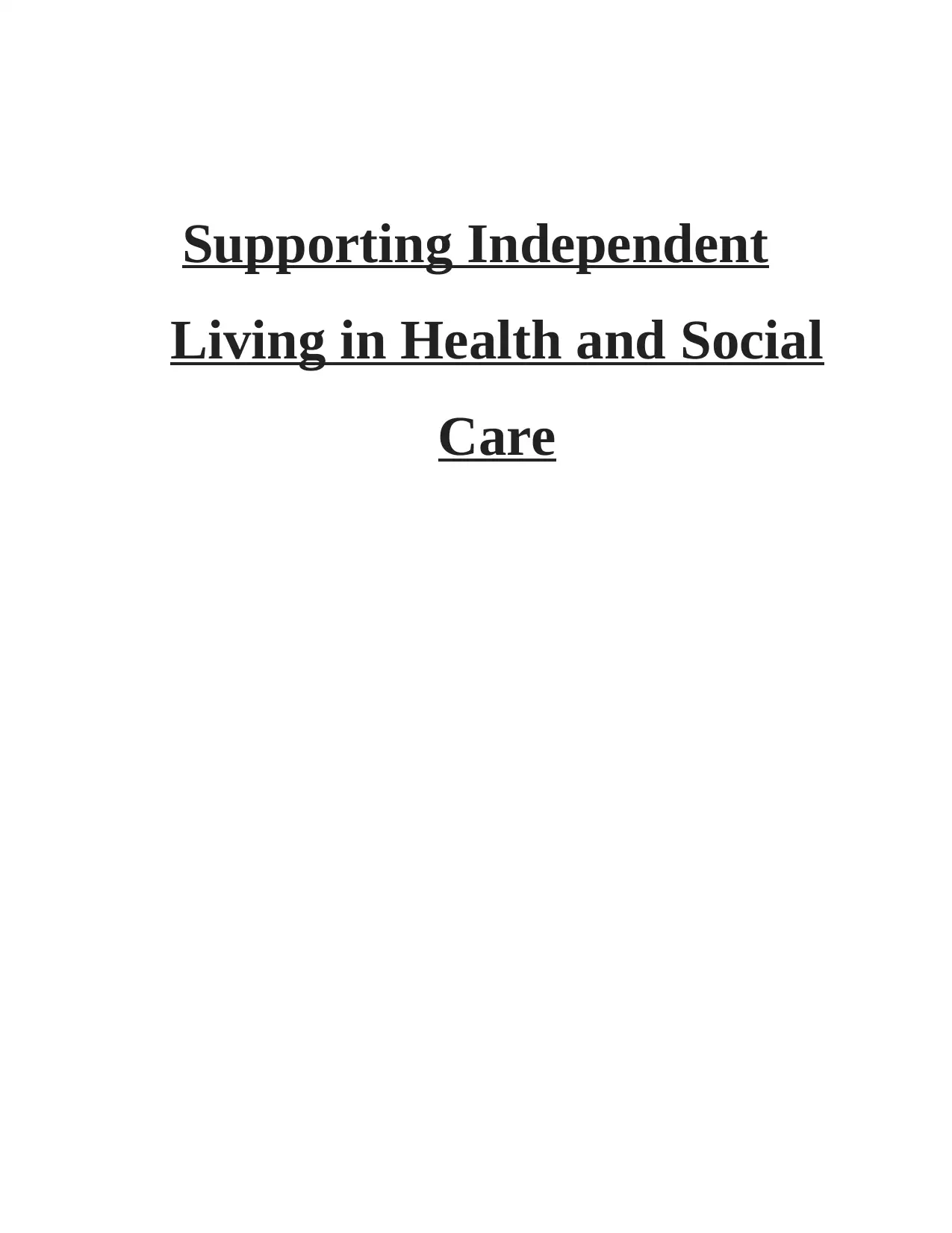
Supporting Independent
Living in Health and Social
Care
Living in Health and Social
Care
Paraphrase This Document
Need a fresh take? Get an instant paraphrase of this document with our AI Paraphraser
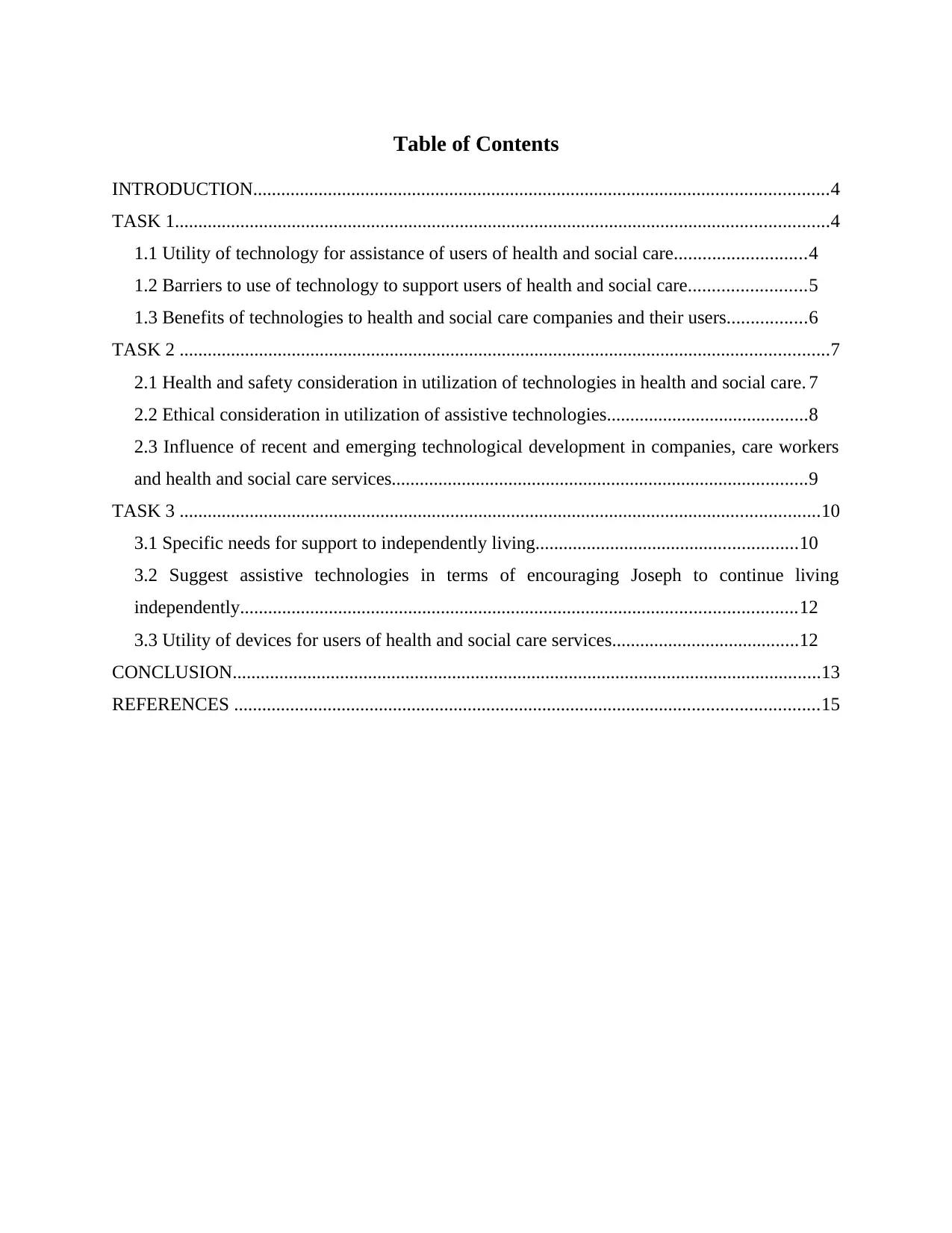
Table of Contents
INTRODUCTION...........................................................................................................................4
TASK 1............................................................................................................................................4
1.1 Utility of technology for assistance of users of health and social care............................4
1.2 Barriers to use of technology to support users of health and social care.........................5
1.3 Benefits of technologies to health and social care companies and their users.................6
TASK 2 ...........................................................................................................................................7
2.1 Health and safety consideration in utilization of technologies in health and social care. 7
2.2 Ethical consideration in utilization of assistive technologies...........................................8
2.3 Influence of recent and emerging technological development in companies, care workers
and health and social care services.........................................................................................9
TASK 3 .........................................................................................................................................10
3.1 Specific needs for support to independently living........................................................10
3.2 Suggest assistive technologies in terms of encouraging Joseph to continue living
independently.......................................................................................................................12
3.3 Utility of devices for users of health and social care services........................................12
CONCLUSION..............................................................................................................................13
REFERENCES .............................................................................................................................15
INTRODUCTION...........................................................................................................................4
TASK 1............................................................................................................................................4
1.1 Utility of technology for assistance of users of health and social care............................4
1.2 Barriers to use of technology to support users of health and social care.........................5
1.3 Benefits of technologies to health and social care companies and their users.................6
TASK 2 ...........................................................................................................................................7
2.1 Health and safety consideration in utilization of technologies in health and social care. 7
2.2 Ethical consideration in utilization of assistive technologies...........................................8
2.3 Influence of recent and emerging technological development in companies, care workers
and health and social care services.........................................................................................9
TASK 3 .........................................................................................................................................10
3.1 Specific needs for support to independently living........................................................10
3.2 Suggest assistive technologies in terms of encouraging Joseph to continue living
independently.......................................................................................................................12
3.3 Utility of devices for users of health and social care services........................................12
CONCLUSION..............................................................................................................................13
REFERENCES .............................................................................................................................15

⊘ This is a preview!⊘
Do you want full access?
Subscribe today to unlock all pages.

Trusted by 1+ million students worldwide
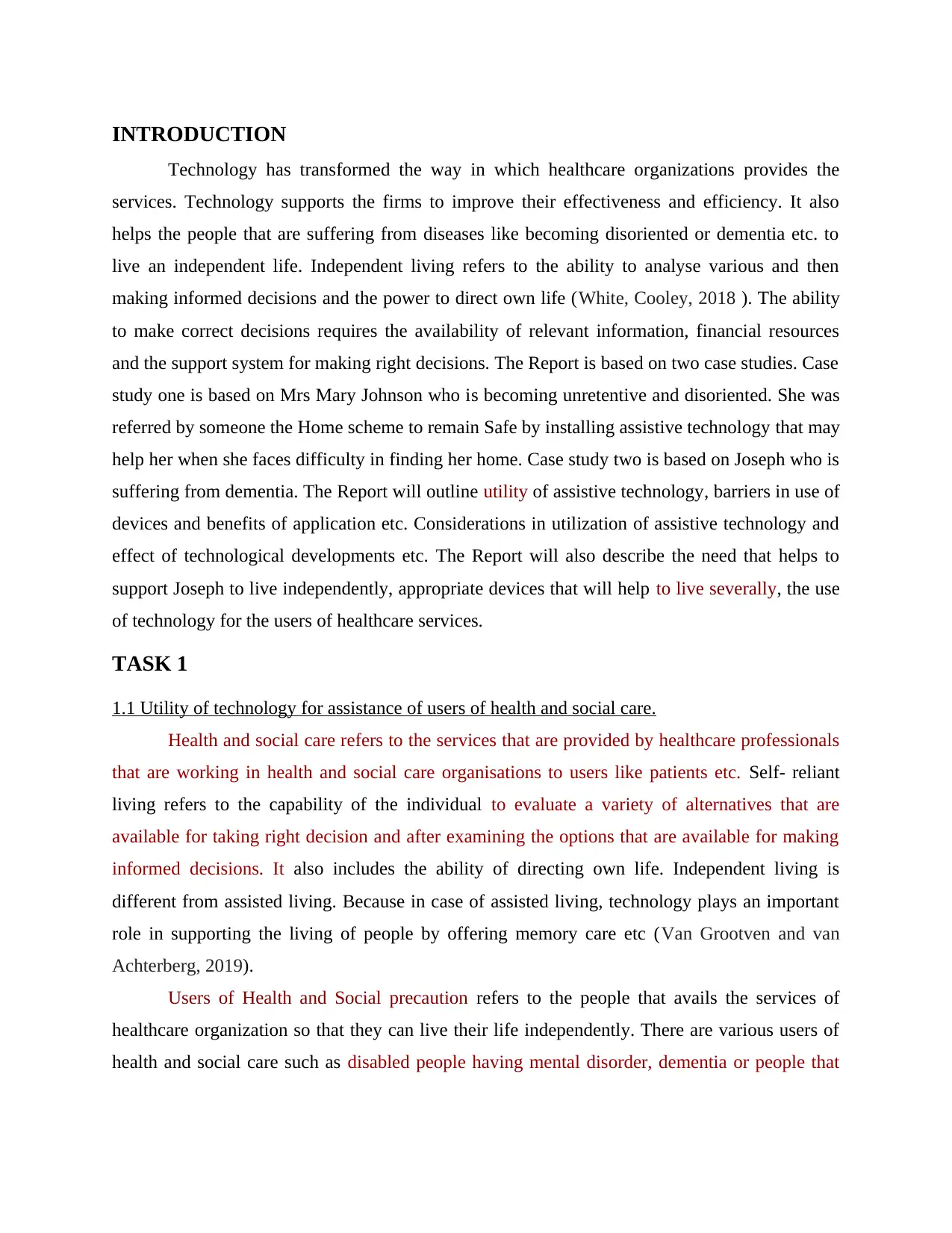
INTRODUCTION
Technology has transformed the way in which healthcare organizations provides the
services. Technology supports the firms to improve their effectiveness and efficiency. It also
helps the people that are suffering from diseases like becoming disoriented or dementia etc. to
live an independent life. Independent living refers to the ability to analyse various and then
making informed decisions and the power to direct own life (White, Cooley, 2018 ). The ability
to make correct decisions requires the availability of relevant information, financial resources
and the support system for making right decisions. The Report is based on two case studies. Case
study one is based on Mrs Mary Johnson who is becoming unretentive and disoriented. She was
referred by someone the Home scheme to remain Safe by installing assistive technology that may
help her when she faces difficulty in finding her home. Case study two is based on Joseph who is
suffering from dementia. The Report will outline utility of assistive technology, barriers in use of
devices and benefits of application etc. Considerations in utilization of assistive technology and
effect of technological developments etc. The Report will also describe the need that helps to
support Joseph to live independently, appropriate devices that will help to live severally, the use
of technology for the users of healthcare services.
TASK 1
1.1 Utility of technology for assistance of users of health and social care.
Health and social care refers to the services that are provided by healthcare professionals
that are working in health and social care organisations to users like patients etc. Self- reliant
living refers to the capability of the individual to evaluate a variety of alternatives that are
available for taking right decision and after examining the options that are available for making
informed decisions. It also includes the ability of directing own life. Independent living is
different from assisted living. Because in case of assisted living, technology plays an important
role in supporting the living of people by offering memory care etc (Van Grootven and van
Achterberg, 2019).
Users of Health and Social precaution refers to the people that avails the services of
healthcare organization so that they can live their life independently. There are various users of
health and social care such as disabled people having mental disorder, dementia or people that
Technology has transformed the way in which healthcare organizations provides the
services. Technology supports the firms to improve their effectiveness and efficiency. It also
helps the people that are suffering from diseases like becoming disoriented or dementia etc. to
live an independent life. Independent living refers to the ability to analyse various and then
making informed decisions and the power to direct own life (White, Cooley, 2018 ). The ability
to make correct decisions requires the availability of relevant information, financial resources
and the support system for making right decisions. The Report is based on two case studies. Case
study one is based on Mrs Mary Johnson who is becoming unretentive and disoriented. She was
referred by someone the Home scheme to remain Safe by installing assistive technology that may
help her when she faces difficulty in finding her home. Case study two is based on Joseph who is
suffering from dementia. The Report will outline utility of assistive technology, barriers in use of
devices and benefits of application etc. Considerations in utilization of assistive technology and
effect of technological developments etc. The Report will also describe the need that helps to
support Joseph to live independently, appropriate devices that will help to live severally, the use
of technology for the users of healthcare services.
TASK 1
1.1 Utility of technology for assistance of users of health and social care.
Health and social care refers to the services that are provided by healthcare professionals
that are working in health and social care organisations to users like patients etc. Self- reliant
living refers to the capability of the individual to evaluate a variety of alternatives that are
available for taking right decision and after examining the options that are available for making
informed decisions. It also includes the ability of directing own life. Independent living is
different from assisted living. Because in case of assisted living, technology plays an important
role in supporting the living of people by offering memory care etc (Van Grootven and van
Achterberg, 2019).
Users of Health and Social precaution refers to the people that avails the services of
healthcare organization so that they can live their life independently. There are various users of
health and social care such as disabled people having mental disorder, dementia or people that
Paraphrase This Document
Need a fresh take? Get an instant paraphrase of this document with our AI Paraphraser
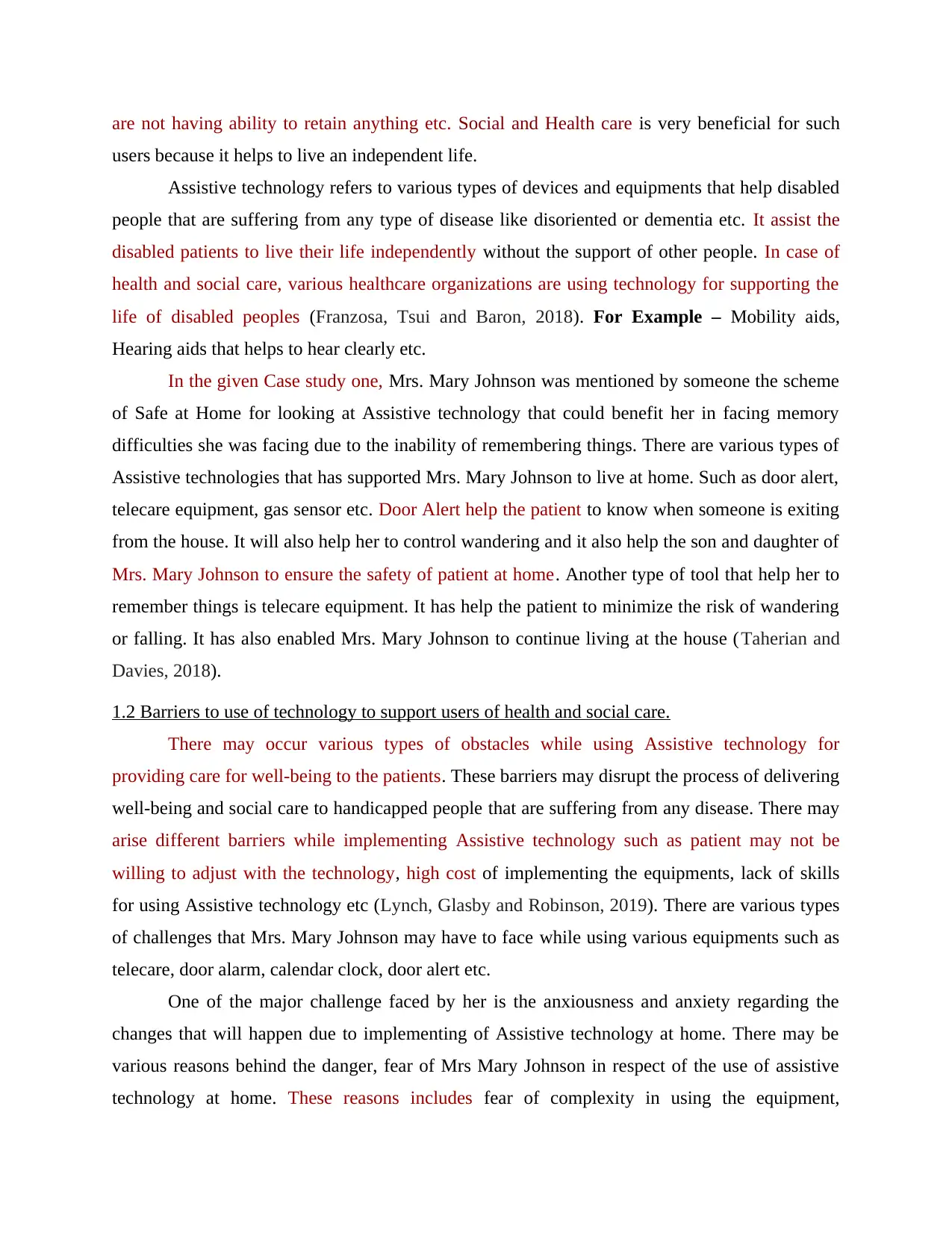
are not having ability to retain anything etc. Social and Health care is very beneficial for such
users because it helps to live an independent life.
Assistive technology refers to various types of devices and equipments that help disabled
people that are suffering from any type of disease like disoriented or dementia etc. It assist the
disabled patients to live their life independently without the support of other people. In case of
health and social care, various healthcare organizations are using technology for supporting the
life of disabled peoples (Franzosa, Tsui and Baron, 2018). For Example – Mobility aids,
Hearing aids that helps to hear clearly etc.
In the given Case study one, Mrs. Mary Johnson was mentioned by someone the scheme
of Safe at Home for looking at Assistive technology that could benefit her in facing memory
difficulties she was facing due to the inability of remembering things. There are various types of
Assistive technologies that has supported Mrs. Mary Johnson to live at home. Such as door alert,
telecare equipment, gas sensor etc. Door Alert help the patient to know when someone is exiting
from the house. It will also help her to control wandering and it also help the son and daughter of
Mrs. Mary Johnson to ensure the safety of patient at home. Another type of tool that help her to
remember things is telecare equipment. It has help the patient to minimize the risk of wandering
or falling. It has also enabled Mrs. Mary Johnson to continue living at the house (Taherian and
Davies, 2018).
1.2 Barriers to use of technology to support users of health and social care.
There may occur various types of obstacles while using Assistive technology for
providing care for well-being to the patients. These barriers may disrupt the process of delivering
well-being and social care to handicapped people that are suffering from any disease. There may
arise different barriers while implementing Assistive technology such as patient may not be
willing to adjust with the technology, high cost of implementing the equipments, lack of skills
for using Assistive technology etc (Lynch, Glasby and Robinson, 2019). There are various types
of challenges that Mrs. Mary Johnson may have to face while using various equipments such as
telecare, door alarm, calendar clock, door alert etc.
One of the major challenge faced by her is the anxiousness and anxiety regarding the
changes that will happen due to implementing of Assistive technology at home. There may be
various reasons behind the danger, fear of Mrs Mary Johnson in respect of the use of assistive
technology at home. These reasons includes fear of complexity in using the equipment,
users because it helps to live an independent life.
Assistive technology refers to various types of devices and equipments that help disabled
people that are suffering from any type of disease like disoriented or dementia etc. It assist the
disabled patients to live their life independently without the support of other people. In case of
health and social care, various healthcare organizations are using technology for supporting the
life of disabled peoples (Franzosa, Tsui and Baron, 2018). For Example – Mobility aids,
Hearing aids that helps to hear clearly etc.
In the given Case study one, Mrs. Mary Johnson was mentioned by someone the scheme
of Safe at Home for looking at Assistive technology that could benefit her in facing memory
difficulties she was facing due to the inability of remembering things. There are various types of
Assistive technologies that has supported Mrs. Mary Johnson to live at home. Such as door alert,
telecare equipment, gas sensor etc. Door Alert help the patient to know when someone is exiting
from the house. It will also help her to control wandering and it also help the son and daughter of
Mrs. Mary Johnson to ensure the safety of patient at home. Another type of tool that help her to
remember things is telecare equipment. It has help the patient to minimize the risk of wandering
or falling. It has also enabled Mrs. Mary Johnson to continue living at the house (Taherian and
Davies, 2018).
1.2 Barriers to use of technology to support users of health and social care.
There may occur various types of obstacles while using Assistive technology for
providing care for well-being to the patients. These barriers may disrupt the process of delivering
well-being and social care to handicapped people that are suffering from any disease. There may
arise different barriers while implementing Assistive technology such as patient may not be
willing to adjust with the technology, high cost of implementing the equipments, lack of skills
for using Assistive technology etc (Lynch, Glasby and Robinson, 2019). There are various types
of challenges that Mrs. Mary Johnson may have to face while using various equipments such as
telecare, door alarm, calendar clock, door alert etc.
One of the major challenge faced by her is the anxiousness and anxiety regarding the
changes that will happen due to implementing of Assistive technology at home. There may be
various reasons behind the danger, fear of Mrs Mary Johnson in respect of the use of assistive
technology at home. These reasons includes fear of complexity in using the equipment,
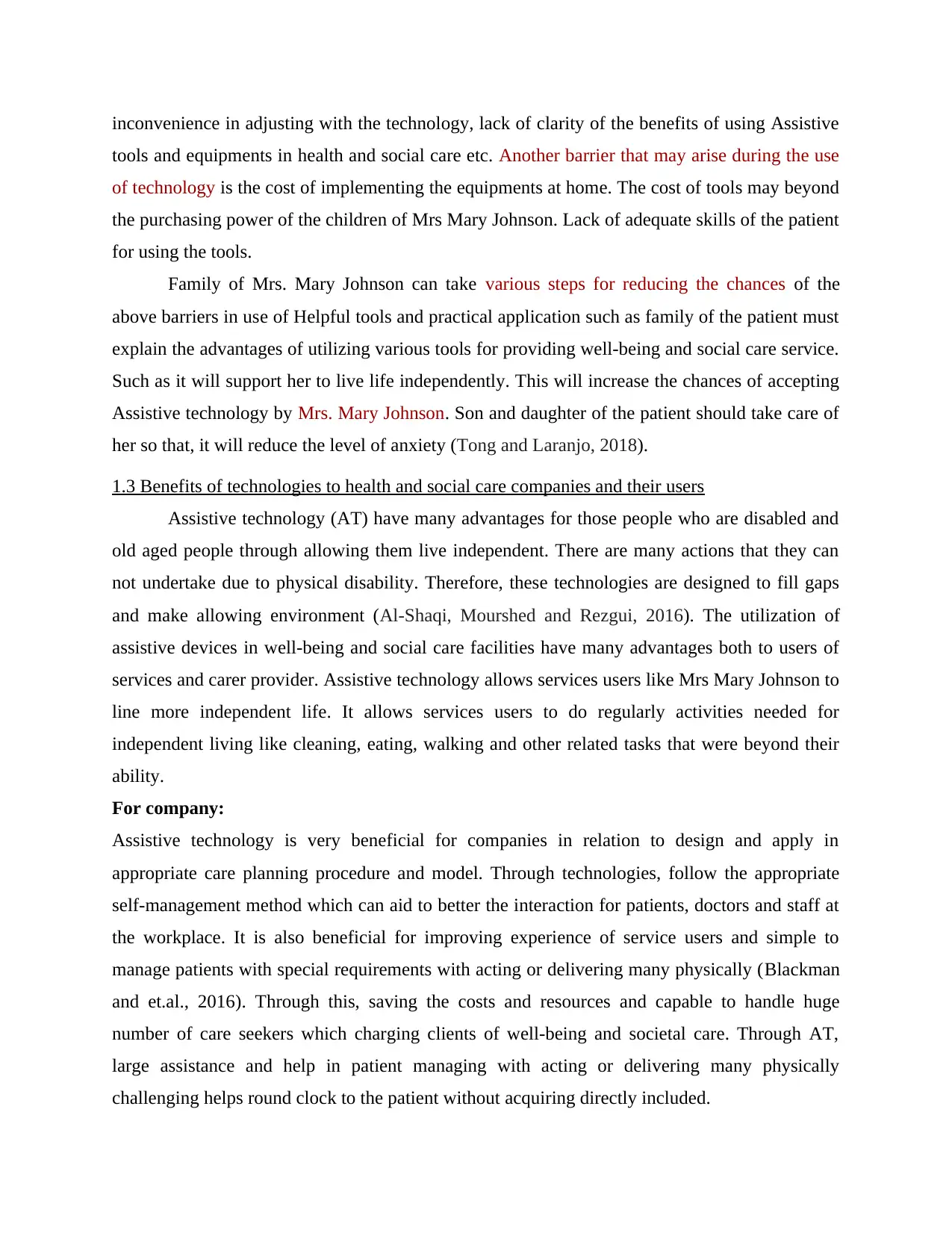
inconvenience in adjusting with the technology, lack of clarity of the benefits of using Assistive
tools and equipments in health and social care etc. Another barrier that may arise during the use
of technology is the cost of implementing the equipments at home. The cost of tools may beyond
the purchasing power of the children of Mrs Mary Johnson. Lack of adequate skills of the patient
for using the tools.
Family of Mrs. Mary Johnson can take various steps for reducing the chances of the
above barriers in use of Helpful tools and practical application such as family of the patient must
explain the advantages of utilizing various tools for providing well-being and social care service.
Such as it will support her to live life independently. This will increase the chances of accepting
Assistive technology by Mrs. Mary Johnson. Son and daughter of the patient should take care of
her so that, it will reduce the level of anxiety (Tong and Laranjo, 2018).
1.3 Benefits of technologies to health and social care companies and their users
Assistive technology (AT) have many advantages for those people who are disabled and
old aged people through allowing them live independent. There are many actions that they can
not undertake due to physical disability. Therefore, these technologies are designed to fill gaps
and make allowing environment (Al-Shaqi, Mourshed and Rezgui, 2016). The utilization of
assistive devices in well-being and social care facilities have many advantages both to users of
services and carer provider. Assistive technology allows services users like Mrs Mary Johnson to
line more independent life. It allows services users to do regularly activities needed for
independent living like cleaning, eating, walking and other related tasks that were beyond their
ability.
For company:
Assistive technology is very beneficial for companies in relation to design and apply in
appropriate care planning procedure and model. Through technologies, follow the appropriate
self-management method which can aid to better the interaction for patients, doctors and staff at
the workplace. It is also beneficial for improving experience of service users and simple to
manage patients with special requirements with acting or delivering many physically (Blackman
and et.al., 2016). Through this, saving the costs and resources and capable to handle huge
number of care seekers which charging clients of well-being and societal care. Through AT,
large assistance and help in patient managing with acting or delivering many physically
challenging helps round clock to the patient without acquiring directly included.
tools and equipments in health and social care etc. Another barrier that may arise during the use
of technology is the cost of implementing the equipments at home. The cost of tools may beyond
the purchasing power of the children of Mrs Mary Johnson. Lack of adequate skills of the patient
for using the tools.
Family of Mrs. Mary Johnson can take various steps for reducing the chances of the
above barriers in use of Helpful tools and practical application such as family of the patient must
explain the advantages of utilizing various tools for providing well-being and social care service.
Such as it will support her to live life independently. This will increase the chances of accepting
Assistive technology by Mrs. Mary Johnson. Son and daughter of the patient should take care of
her so that, it will reduce the level of anxiety (Tong and Laranjo, 2018).
1.3 Benefits of technologies to health and social care companies and their users
Assistive technology (AT) have many advantages for those people who are disabled and
old aged people through allowing them live independent. There are many actions that they can
not undertake due to physical disability. Therefore, these technologies are designed to fill gaps
and make allowing environment (Al-Shaqi, Mourshed and Rezgui, 2016). The utilization of
assistive devices in well-being and social care facilities have many advantages both to users of
services and carer provider. Assistive technology allows services users like Mrs Mary Johnson to
line more independent life. It allows services users to do regularly activities needed for
independent living like cleaning, eating, walking and other related tasks that were beyond their
ability.
For company:
Assistive technology is very beneficial for companies in relation to design and apply in
appropriate care planning procedure and model. Through technologies, follow the appropriate
self-management method which can aid to better the interaction for patients, doctors and staff at
the workplace. It is also beneficial for improving experience of service users and simple to
manage patients with special requirements with acting or delivering many physically (Blackman
and et.al., 2016). Through this, saving the costs and resources and capable to handle huge
number of care seekers which charging clients of well-being and societal care. Through AT,
large assistance and help in patient managing with acting or delivering many physically
challenging helps round clock to the patient without acquiring directly included.
⊘ This is a preview!⊘
Do you want full access?
Subscribe today to unlock all pages.

Trusted by 1+ million students worldwide
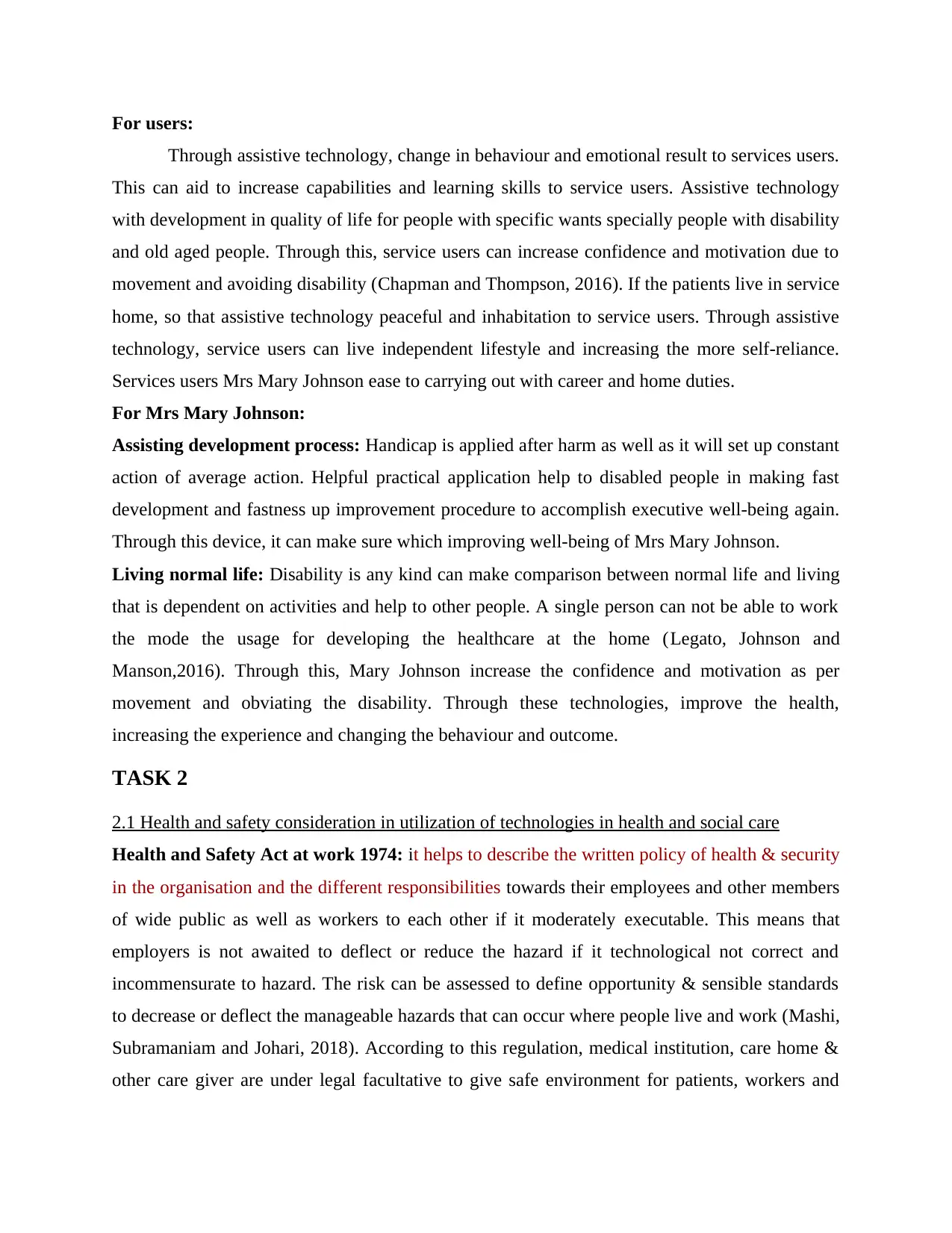
For users:
Through assistive technology, change in behaviour and emotional result to services users.
This can aid to increase capabilities and learning skills to service users. Assistive technology
with development in quality of life for people with specific wants specially people with disability
and old aged people. Through this, service users can increase confidence and motivation due to
movement and avoiding disability (Chapman and Thompson, 2016). If the patients live in service
home, so that assistive technology peaceful and inhabitation to service users. Through assistive
technology, service users can live independent lifestyle and increasing the more self-reliance.
Services users Mrs Mary Johnson ease to carrying out with career and home duties.
For Mrs Mary Johnson:
Assisting development process: Handicap is applied after harm as well as it will set up constant
action of average action. Helpful practical application help to disabled people in making fast
development and fastness up improvement procedure to accomplish executive well-being again.
Through this device, it can make sure which improving well-being of Mrs Mary Johnson.
Living normal life: Disability is any kind can make comparison between normal life and living
that is dependent on activities and help to other people. A single person can not be able to work
the mode the usage for developing the healthcare at the home (Legato, Johnson and
Manson,2016). Through this, Mary Johnson increase the confidence and motivation as per
movement and obviating the disability. Through these technologies, improve the health,
increasing the experience and changing the behaviour and outcome.
TASK 2
2.1 Health and safety consideration in utilization of technologies in health and social care
Health and Safety Act at work 1974: it helps to describe the written policy of health & security
in the organisation and the different responsibilities towards their employees and other members
of wide public as well as workers to each other if it moderately executable. This means that
employers is not awaited to deflect or reduce the hazard if it technological not correct and
incommensurate to hazard. The risk can be assessed to define opportunity & sensible standards
to decrease or deflect the manageable hazards that can occur where people live and work (Mashi,
Subramaniam and Johari, 2018). According to this regulation, medical institution, care home &
other care giver are under legal facultative to give safe environment for patients, workers and
Through assistive technology, change in behaviour and emotional result to services users.
This can aid to increase capabilities and learning skills to service users. Assistive technology
with development in quality of life for people with specific wants specially people with disability
and old aged people. Through this, service users can increase confidence and motivation due to
movement and avoiding disability (Chapman and Thompson, 2016). If the patients live in service
home, so that assistive technology peaceful and inhabitation to service users. Through assistive
technology, service users can live independent lifestyle and increasing the more self-reliance.
Services users Mrs Mary Johnson ease to carrying out with career and home duties.
For Mrs Mary Johnson:
Assisting development process: Handicap is applied after harm as well as it will set up constant
action of average action. Helpful practical application help to disabled people in making fast
development and fastness up improvement procedure to accomplish executive well-being again.
Through this device, it can make sure which improving well-being of Mrs Mary Johnson.
Living normal life: Disability is any kind can make comparison between normal life and living
that is dependent on activities and help to other people. A single person can not be able to work
the mode the usage for developing the healthcare at the home (Legato, Johnson and
Manson,2016). Through this, Mary Johnson increase the confidence and motivation as per
movement and obviating the disability. Through these technologies, improve the health,
increasing the experience and changing the behaviour and outcome.
TASK 2
2.1 Health and safety consideration in utilization of technologies in health and social care
Health and Safety Act at work 1974: it helps to describe the written policy of health & security
in the organisation and the different responsibilities towards their employees and other members
of wide public as well as workers to each other if it moderately executable. This means that
employers is not awaited to deflect or reduce the hazard if it technological not correct and
incommensurate to hazard. The risk can be assessed to define opportunity & sensible standards
to decrease or deflect the manageable hazards that can occur where people live and work (Mashi,
Subramaniam and Johari, 2018). According to this regulation, medical institution, care home &
other care giver are under legal facultative to give safe environment for patients, workers and
Paraphrase This Document
Need a fresh take? Get an instant paraphrase of this document with our AI Paraphraser
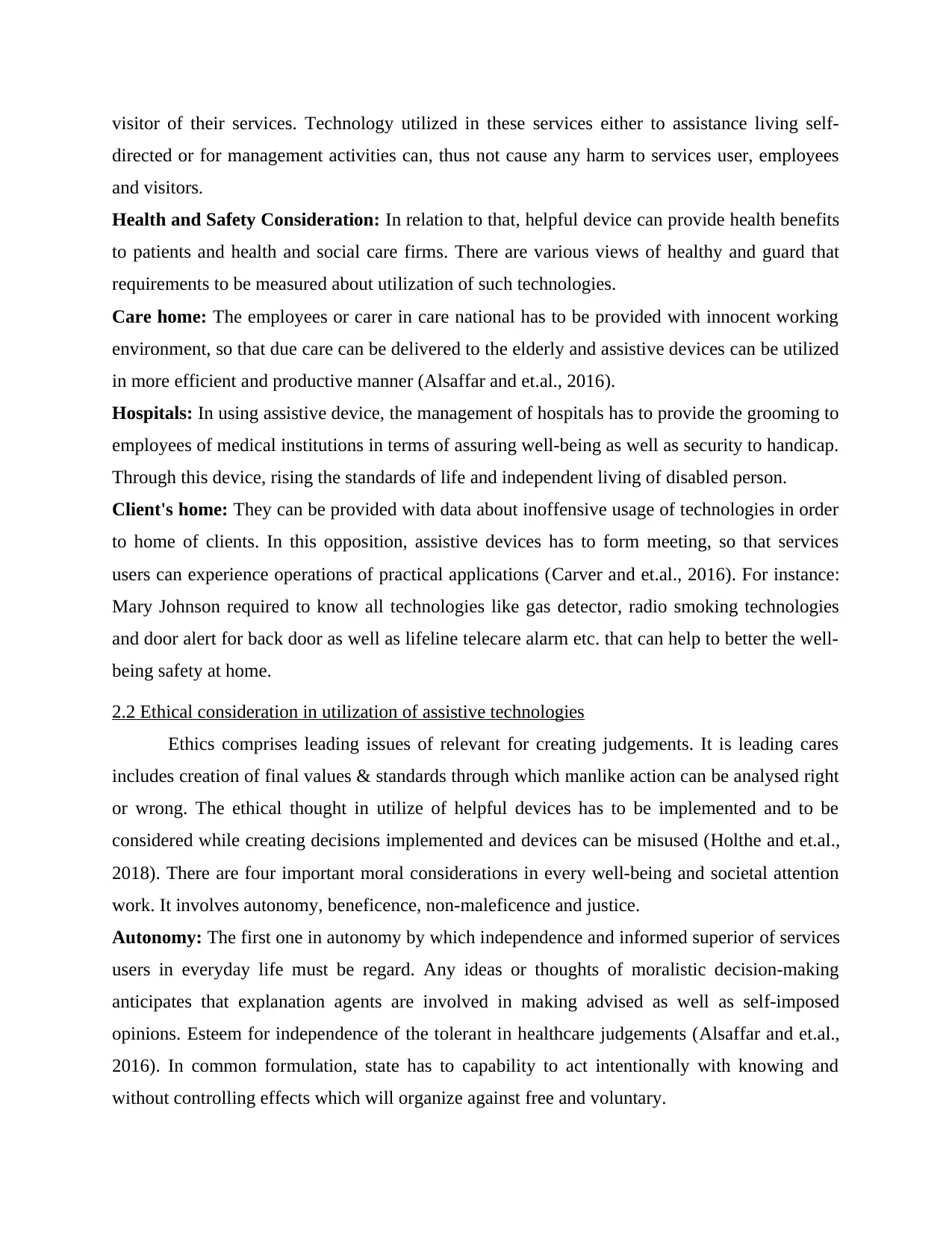
visitor of their services. Technology utilized in these services either to assistance living self-
directed or for management activities can, thus not cause any harm to services user, employees
and visitors.
Health and Safety Consideration: In relation to that, helpful device can provide health benefits
to patients and health and social care firms. There are various views of healthy and guard that
requirements to be measured about utilization of such technologies.
Care home: The employees or carer in care national has to be provided with innocent working
environment, so that due care can be delivered to the elderly and assistive devices can be utilized
in more efficient and productive manner (Alsaffar and et.al., 2016).
Hospitals: In using assistive device, the management of hospitals has to provide the grooming to
employees of medical institutions in terms of assuring well-being as well as security to handicap.
Through this device, rising the standards of life and independent living of disabled person.
Client's home: They can be provided with data about inoffensive usage of technologies in order
to home of clients. In this opposition, assistive devices has to form meeting, so that services
users can experience operations of practical applications (Carver and et.al., 2016). For instance:
Mary Johnson required to know all technologies like gas detector, radio smoking technologies
and door alert for back door as well as lifeline telecare alarm etc. that can help to better the well-
being safety at home.
2.2 Ethical consideration in utilization of assistive technologies
Ethics comprises leading issues of relevant for creating judgements. It is leading cares
includes creation of final values & standards through which manlike action can be analysed right
or wrong. The ethical thought in utilize of helpful devices has to be implemented and to be
considered while creating decisions implemented and devices can be misused (Holthe and et.al.,
2018). There are four important moral considerations in every well-being and societal attention
work. It involves autonomy, beneficence, non-maleficence and justice.
Autonomy: The first one in autonomy by which independence and informed superior of services
users in everyday life must be regard. Any ideas or thoughts of moralistic decision-making
anticipates that explanation agents are involved in making advised as well as self-imposed
opinions. Esteem for independence of the tolerant in healthcare judgements (Alsaffar and et.al.,
2016). In common formulation, state has to capability to act intentionally with knowing and
without controlling effects which will organize against free and voluntary.
directed or for management activities can, thus not cause any harm to services user, employees
and visitors.
Health and Safety Consideration: In relation to that, helpful device can provide health benefits
to patients and health and social care firms. There are various views of healthy and guard that
requirements to be measured about utilization of such technologies.
Care home: The employees or carer in care national has to be provided with innocent working
environment, so that due care can be delivered to the elderly and assistive devices can be utilized
in more efficient and productive manner (Alsaffar and et.al., 2016).
Hospitals: In using assistive device, the management of hospitals has to provide the grooming to
employees of medical institutions in terms of assuring well-being as well as security to handicap.
Through this device, rising the standards of life and independent living of disabled person.
Client's home: They can be provided with data about inoffensive usage of technologies in order
to home of clients. In this opposition, assistive devices has to form meeting, so that services
users can experience operations of practical applications (Carver and et.al., 2016). For instance:
Mary Johnson required to know all technologies like gas detector, radio smoking technologies
and door alert for back door as well as lifeline telecare alarm etc. that can help to better the well-
being safety at home.
2.2 Ethical consideration in utilization of assistive technologies
Ethics comprises leading issues of relevant for creating judgements. It is leading cares
includes creation of final values & standards through which manlike action can be analysed right
or wrong. The ethical thought in utilize of helpful devices has to be implemented and to be
considered while creating decisions implemented and devices can be misused (Holthe and et.al.,
2018). There are four important moral considerations in every well-being and societal attention
work. It involves autonomy, beneficence, non-maleficence and justice.
Autonomy: The first one in autonomy by which independence and informed superior of services
users in everyday life must be regard. Any ideas or thoughts of moralistic decision-making
anticipates that explanation agents are involved in making advised as well as self-imposed
opinions. Esteem for independence of the tolerant in healthcare judgements (Alsaffar and et.al.,
2016). In common formulation, state has to capability to act intentionally with knowing and
without controlling effects which will organize against free and voluntary.
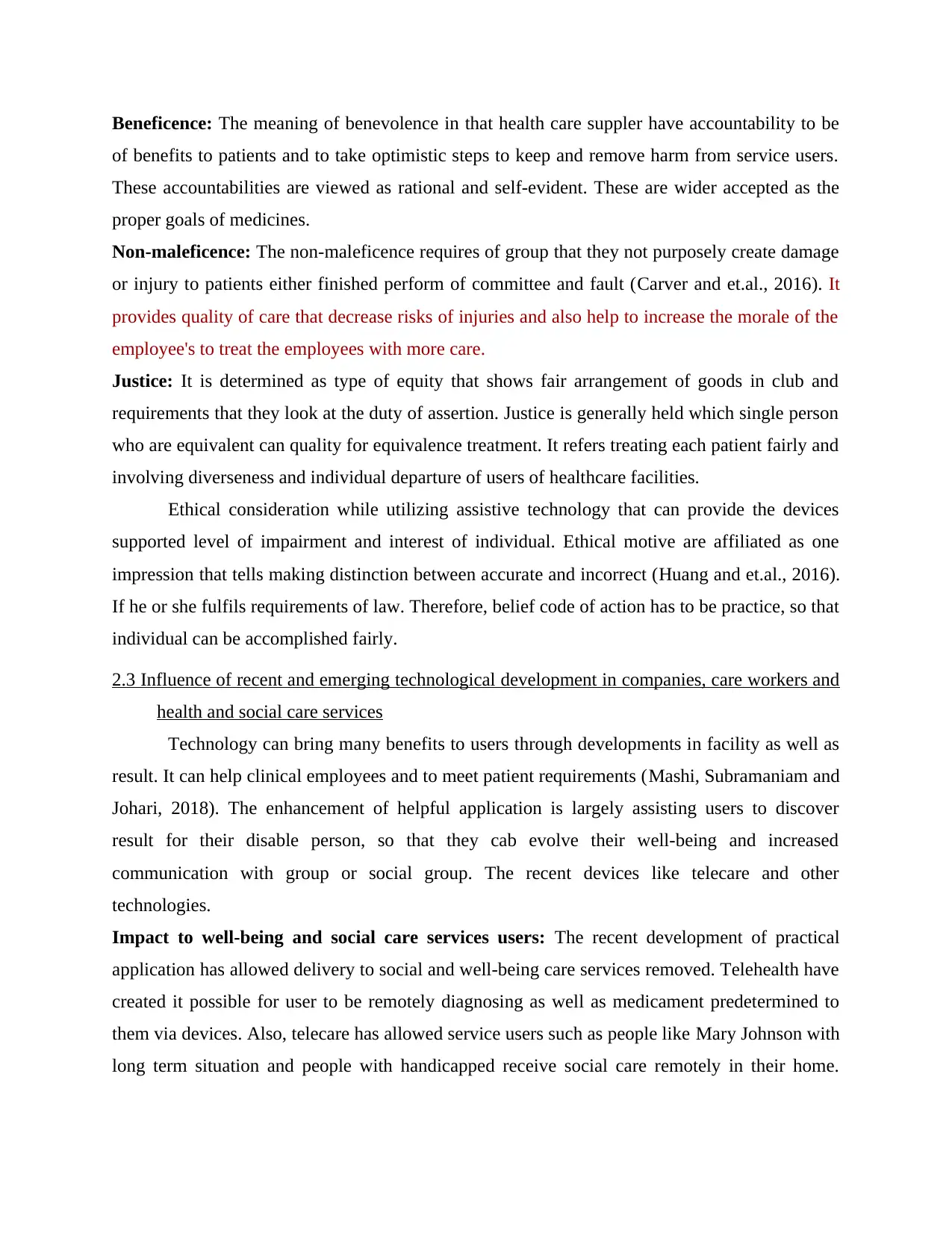
Beneficence: The meaning of benevolence in that health care suppler have accountability to be
of benefits to patients and to take optimistic steps to keep and remove harm from service users.
These accountabilities are viewed as rational and self-evident. These are wider accepted as the
proper goals of medicines.
Non-maleficence: The non-maleficence requires of group that they not purposely create damage
or injury to patients either finished perform of committee and fault (Carver and et.al., 2016). It
provides quality of care that decrease risks of injuries and also help to increase the morale of the
employee's to treat the employees with more care.
Justice: It is determined as type of equity that shows fair arrangement of goods in club and
requirements that they look at the duty of assertion. Justice is generally held which single person
who are equivalent can quality for equivalence treatment. It refers treating each patient fairly and
involving diverseness and individual departure of users of healthcare facilities.
Ethical consideration while utilizing assistive technology that can provide the devices
supported level of impairment and interest of individual. Ethical motive are affiliated as one
impression that tells making distinction between accurate and incorrect (Huang and et.al., 2016).
If he or she fulfils requirements of law. Therefore, belief code of action has to be practice, so that
individual can be accomplished fairly.
2.3 Influence of recent and emerging technological development in companies, care workers and
health and social care services
Technology can bring many benefits to users through developments in facility as well as
result. It can help clinical employees and to meet patient requirements (Mashi, Subramaniam and
Johari, 2018). The enhancement of helpful application is largely assisting users to discover
result for their disable person, so that they cab evolve their well-being and increased
communication with group or social group. The recent devices like telecare and other
technologies.
Impact to well-being and social care services users: The recent development of practical
application has allowed delivery to social and well-being care services removed. Telehealth have
created it possible for user to be remotely diagnosing as well as medicament predetermined to
them via devices. Also, telecare has allowed service users such as people like Mary Johnson with
long term situation and people with handicapped receive social care remotely in their home.
of benefits to patients and to take optimistic steps to keep and remove harm from service users.
These accountabilities are viewed as rational and self-evident. These are wider accepted as the
proper goals of medicines.
Non-maleficence: The non-maleficence requires of group that they not purposely create damage
or injury to patients either finished perform of committee and fault (Carver and et.al., 2016). It
provides quality of care that decrease risks of injuries and also help to increase the morale of the
employee's to treat the employees with more care.
Justice: It is determined as type of equity that shows fair arrangement of goods in club and
requirements that they look at the duty of assertion. Justice is generally held which single person
who are equivalent can quality for equivalence treatment. It refers treating each patient fairly and
involving diverseness and individual departure of users of healthcare facilities.
Ethical consideration while utilizing assistive technology that can provide the devices
supported level of impairment and interest of individual. Ethical motive are affiliated as one
impression that tells making distinction between accurate and incorrect (Huang and et.al., 2016).
If he or she fulfils requirements of law. Therefore, belief code of action has to be practice, so that
individual can be accomplished fairly.
2.3 Influence of recent and emerging technological development in companies, care workers and
health and social care services
Technology can bring many benefits to users through developments in facility as well as
result. It can help clinical employees and to meet patient requirements (Mashi, Subramaniam and
Johari, 2018). The enhancement of helpful application is largely assisting users to discover
result for their disable person, so that they cab evolve their well-being and increased
communication with group or social group. The recent devices like telecare and other
technologies.
Impact to well-being and social care services users: The recent development of practical
application has allowed delivery to social and well-being care services removed. Telehealth have
created it possible for user to be remotely diagnosing as well as medicament predetermined to
them via devices. Also, telecare has allowed service users such as people like Mary Johnson with
long term situation and people with handicapped receive social care remotely in their home.
⊘ This is a preview!⊘
Do you want full access?
Subscribe today to unlock all pages.

Trusted by 1+ million students worldwide
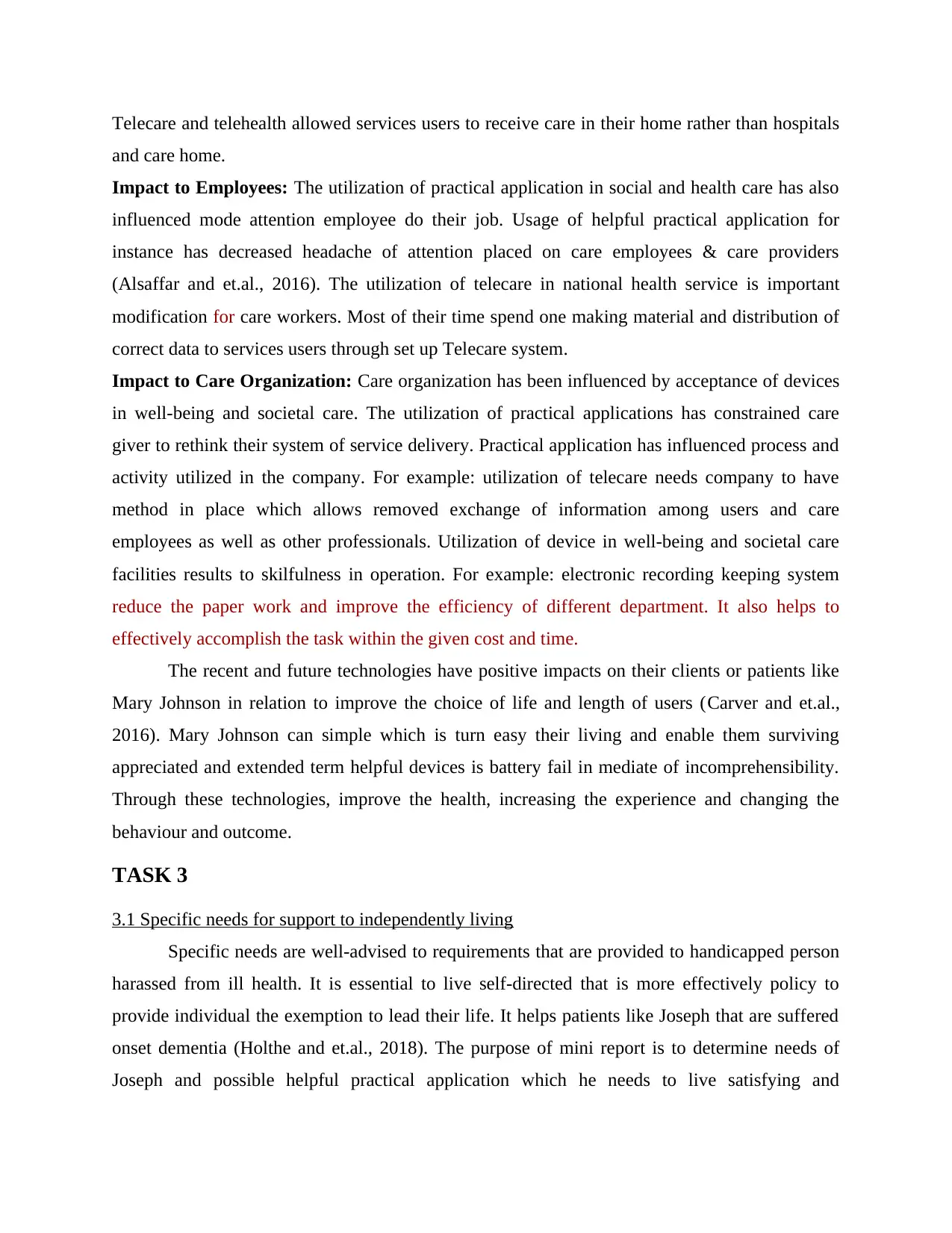
Telecare and telehealth allowed services users to receive care in their home rather than hospitals
and care home.
Impact to Employees: The utilization of practical application in social and health care has also
influenced mode attention employee do their job. Usage of helpful practical application for
instance has decreased headache of attention placed on care employees & care providers
(Alsaffar and et.al., 2016). The utilization of telecare in national health service is important
modification for care workers. Most of their time spend one making material and distribution of
correct data to services users through set up Telecare system.
Impact to Care Organization: Care organization has been influenced by acceptance of devices
in well-being and societal care. The utilization of practical applications has constrained care
giver to rethink their system of service delivery. Practical application has influenced process and
activity utilized in the company. For example: utilization of telecare needs company to have
method in place which allows removed exchange of information among users and care
employees as well as other professionals. Utilization of device in well-being and societal care
facilities results to skilfulness in operation. For example: electronic recording keeping system
reduce the paper work and improve the efficiency of different department. It also helps to
effectively accomplish the task within the given cost and time.
The recent and future technologies have positive impacts on their clients or patients like
Mary Johnson in relation to improve the choice of life and length of users (Carver and et.al.,
2016). Mary Johnson can simple which is turn easy their living and enable them surviving
appreciated and extended term helpful devices is battery fail in mediate of incomprehensibility.
Through these technologies, improve the health, increasing the experience and changing the
behaviour and outcome.
TASK 3
3.1 Specific needs for support to independently living
Specific needs are well-advised to requirements that are provided to handicapped person
harassed from ill health. It is essential to live self-directed that is more effectively policy to
provide individual the exemption to lead their life. It helps patients like Joseph that are suffered
onset dementia (Holthe and et.al., 2018). The purpose of mini report is to determine needs of
Joseph and possible helpful practical application which he needs to live satisfying and
and care home.
Impact to Employees: The utilization of practical application in social and health care has also
influenced mode attention employee do their job. Usage of helpful practical application for
instance has decreased headache of attention placed on care employees & care providers
(Alsaffar and et.al., 2016). The utilization of telecare in national health service is important
modification for care workers. Most of their time spend one making material and distribution of
correct data to services users through set up Telecare system.
Impact to Care Organization: Care organization has been influenced by acceptance of devices
in well-being and societal care. The utilization of practical applications has constrained care
giver to rethink their system of service delivery. Practical application has influenced process and
activity utilized in the company. For example: utilization of telecare needs company to have
method in place which allows removed exchange of information among users and care
employees as well as other professionals. Utilization of device in well-being and societal care
facilities results to skilfulness in operation. For example: electronic recording keeping system
reduce the paper work and improve the efficiency of different department. It also helps to
effectively accomplish the task within the given cost and time.
The recent and future technologies have positive impacts on their clients or patients like
Mary Johnson in relation to improve the choice of life and length of users (Carver and et.al.,
2016). Mary Johnson can simple which is turn easy their living and enable them surviving
appreciated and extended term helpful devices is battery fail in mediate of incomprehensibility.
Through these technologies, improve the health, increasing the experience and changing the
behaviour and outcome.
TASK 3
3.1 Specific needs for support to independently living
Specific needs are well-advised to requirements that are provided to handicapped person
harassed from ill health. It is essential to live self-directed that is more effectively policy to
provide individual the exemption to lead their life. It helps patients like Joseph that are suffered
onset dementia (Holthe and et.al., 2018). The purpose of mini report is to determine needs of
Joseph and possible helpful practical application which he needs to live satisfying and
Paraphrase This Document
Need a fresh take? Get an instant paraphrase of this document with our AI Paraphraser
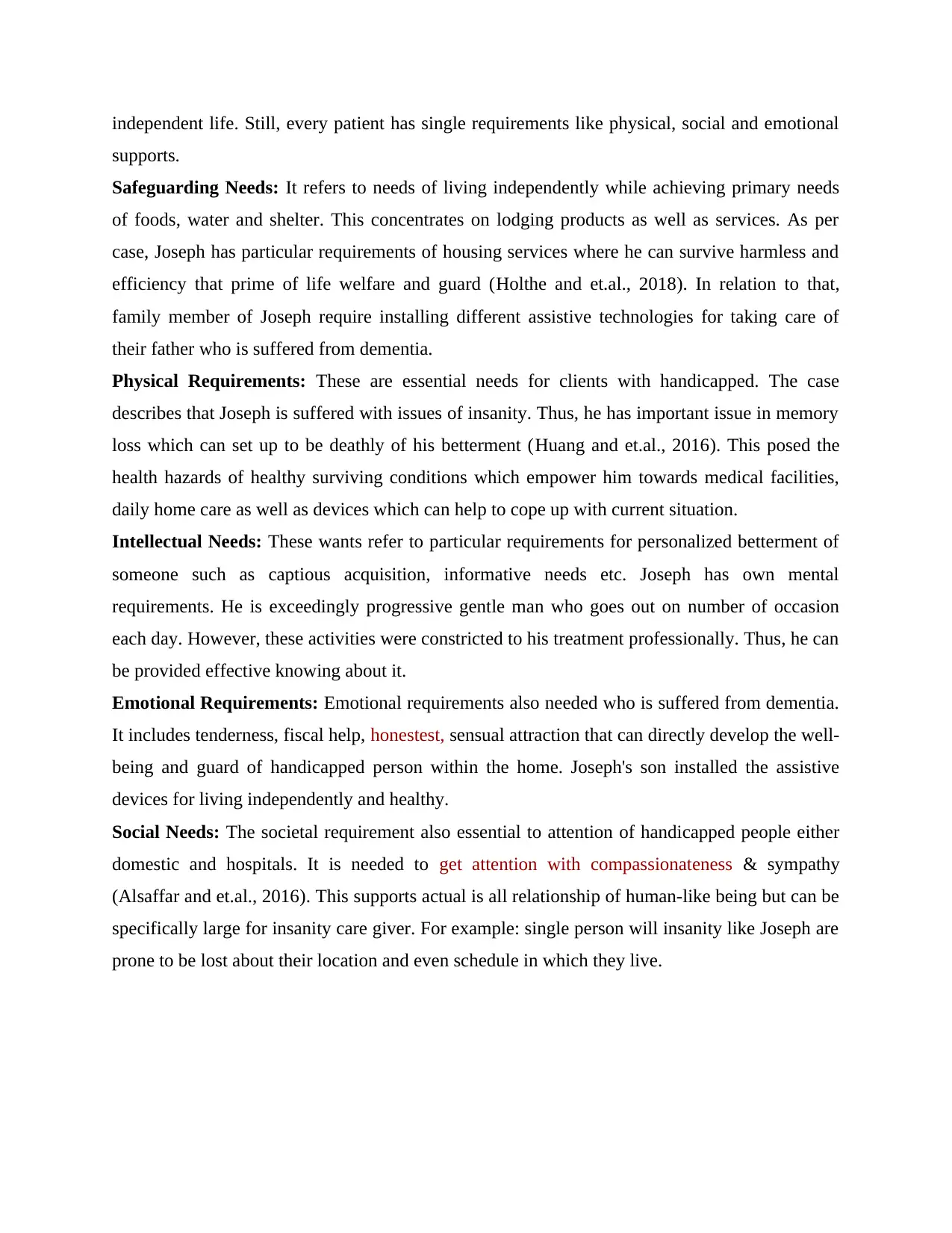
independent life. Still, every patient has single requirements like physical, social and emotional
supports.
Safeguarding Needs: It refers to needs of living independently while achieving primary needs
of foods, water and shelter. This concentrates on lodging products as well as services. As per
case, Joseph has particular requirements of housing services where he can survive harmless and
efficiency that prime of life welfare and guard (Holthe and et.al., 2018). In relation to that,
family member of Joseph require installing different assistive technologies for taking care of
their father who is suffered from dementia.
Physical Requirements: These are essential needs for clients with handicapped. The case
describes that Joseph is suffered with issues of insanity. Thus, he has important issue in memory
loss which can set up to be deathly of his betterment (Huang and et.al., 2016). This posed the
health hazards of healthy surviving conditions which empower him towards medical facilities,
daily home care as well as devices which can help to cope up with current situation.
Intellectual Needs: These wants refer to particular requirements for personalized betterment of
someone such as captious acquisition, informative needs etc. Joseph has own mental
requirements. He is exceedingly progressive gentle man who goes out on number of occasion
each day. However, these activities were constricted to his treatment professionally. Thus, he can
be provided effective knowing about it.
Emotional Requirements: Emotional requirements also needed who is suffered from dementia.
It includes tenderness, fiscal help, honestest, sensual attraction that can directly develop the well-
being and guard of handicapped person within the home. Joseph's son installed the assistive
devices for living independently and healthy.
Social Needs: The societal requirement also essential to attention of handicapped people either
domestic and hospitals. It is needed to get attention with compassionateness & sympathy
(Alsaffar and et.al., 2016). This supports actual is all relationship of human-like being but can be
specifically large for insanity care giver. For example: single person will insanity like Joseph are
prone to be lost about their location and even schedule in which they live.
supports.
Safeguarding Needs: It refers to needs of living independently while achieving primary needs
of foods, water and shelter. This concentrates on lodging products as well as services. As per
case, Joseph has particular requirements of housing services where he can survive harmless and
efficiency that prime of life welfare and guard (Holthe and et.al., 2018). In relation to that,
family member of Joseph require installing different assistive technologies for taking care of
their father who is suffered from dementia.
Physical Requirements: These are essential needs for clients with handicapped. The case
describes that Joseph is suffered with issues of insanity. Thus, he has important issue in memory
loss which can set up to be deathly of his betterment (Huang and et.al., 2016). This posed the
health hazards of healthy surviving conditions which empower him towards medical facilities,
daily home care as well as devices which can help to cope up with current situation.
Intellectual Needs: These wants refer to particular requirements for personalized betterment of
someone such as captious acquisition, informative needs etc. Joseph has own mental
requirements. He is exceedingly progressive gentle man who goes out on number of occasion
each day. However, these activities were constricted to his treatment professionally. Thus, he can
be provided effective knowing about it.
Emotional Requirements: Emotional requirements also needed who is suffered from dementia.
It includes tenderness, fiscal help, honestest, sensual attraction that can directly develop the well-
being and guard of handicapped person within the home. Joseph's son installed the assistive
devices for living independently and healthy.
Social Needs: The societal requirement also essential to attention of handicapped people either
domestic and hospitals. It is needed to get attention with compassionateness & sympathy
(Alsaffar and et.al., 2016). This supports actual is all relationship of human-like being but can be
specifically large for insanity care giver. For example: single person will insanity like Joseph are
prone to be lost about their location and even schedule in which they live.
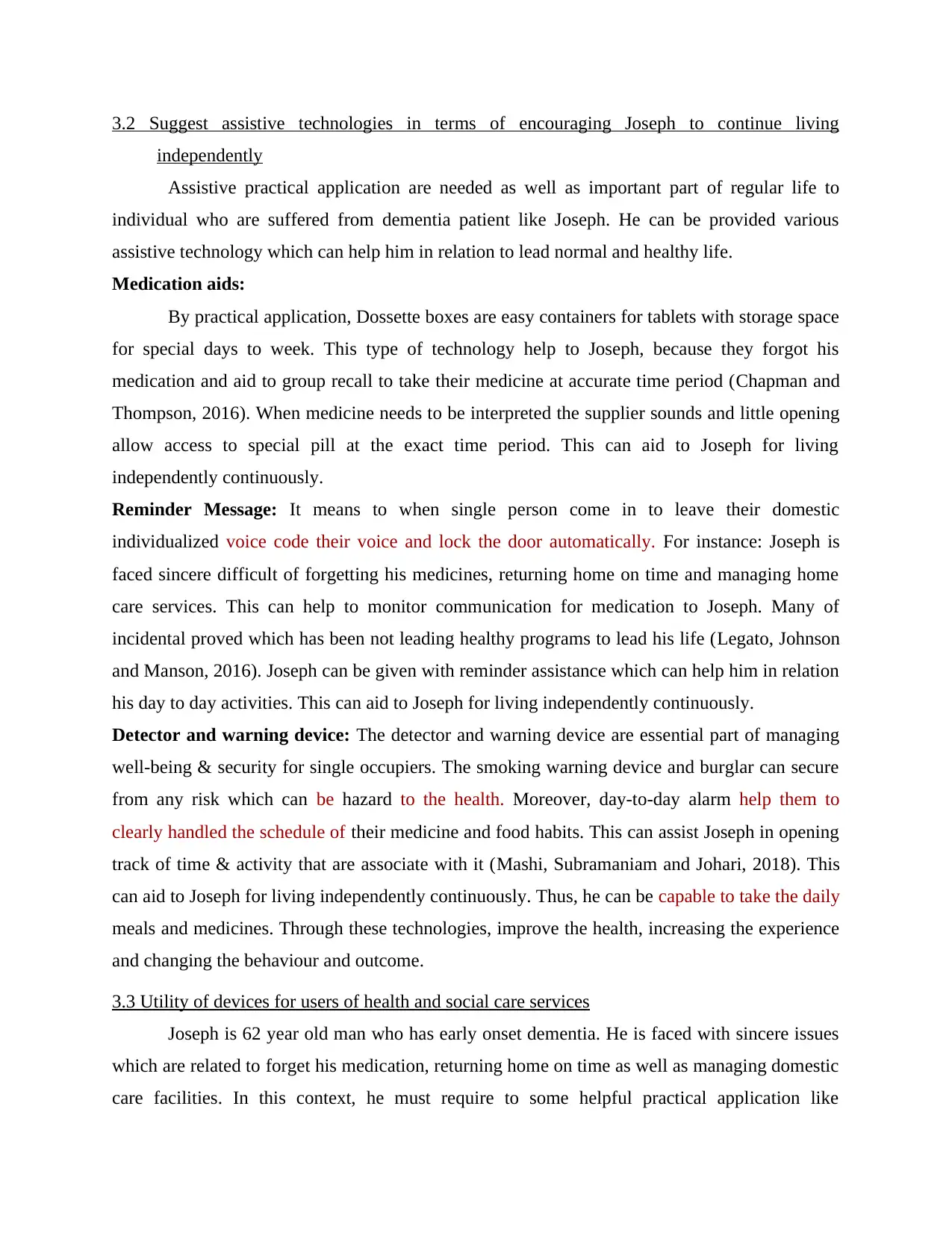
3.2 Suggest assistive technologies in terms of encouraging Joseph to continue living
independently
Assistive practical application are needed as well as important part of regular life to
individual who are suffered from dementia patient like Joseph. He can be provided various
assistive technology which can help him in relation to lead normal and healthy life.
Medication aids:
By practical application, Dossette boxes are easy containers for tablets with storage space
for special days to week. This type of technology help to Joseph, because they forgot his
medication and aid to group recall to take their medicine at accurate time period (Chapman and
Thompson, 2016). When medicine needs to be interpreted the supplier sounds and little opening
allow access to special pill at the exact time period. This can aid to Joseph for living
independently continuously.
Reminder Message: It means to when single person come in to leave their domestic
individualized voice code their voice and lock the door automatically. For instance: Joseph is
faced sincere difficult of forgetting his medicines, returning home on time and managing home
care services. This can help to monitor communication for medication to Joseph. Many of
incidental proved which has been not leading healthy programs to lead his life (Legato, Johnson
and Manson, 2016). Joseph can be given with reminder assistance which can help him in relation
his day to day activities. This can aid to Joseph for living independently continuously.
Detector and warning device: The detector and warning device are essential part of managing
well-being & security for single occupiers. The smoking warning device and burglar can secure
from any risk which can be hazard to the health. Moreover, day-to-day alarm help them to
clearly handled the schedule of their medicine and food habits. This can assist Joseph in opening
track of time & activity that are associate with it (Mashi, Subramaniam and Johari, 2018). This
can aid to Joseph for living independently continuously. Thus, he can be capable to take the daily
meals and medicines. Through these technologies, improve the health, increasing the experience
and changing the behaviour and outcome.
3.3 Utility of devices for users of health and social care services
Joseph is 62 year old man who has early onset dementia. He is faced with sincere issues
which are related to forget his medication, returning home on time as well as managing domestic
care facilities. In this context, he must require to some helpful practical application like
independently
Assistive practical application are needed as well as important part of regular life to
individual who are suffered from dementia patient like Joseph. He can be provided various
assistive technology which can help him in relation to lead normal and healthy life.
Medication aids:
By practical application, Dossette boxes are easy containers for tablets with storage space
for special days to week. This type of technology help to Joseph, because they forgot his
medication and aid to group recall to take their medicine at accurate time period (Chapman and
Thompson, 2016). When medicine needs to be interpreted the supplier sounds and little opening
allow access to special pill at the exact time period. This can aid to Joseph for living
independently continuously.
Reminder Message: It means to when single person come in to leave their domestic
individualized voice code their voice and lock the door automatically. For instance: Joseph is
faced sincere difficult of forgetting his medicines, returning home on time and managing home
care services. This can help to monitor communication for medication to Joseph. Many of
incidental proved which has been not leading healthy programs to lead his life (Legato, Johnson
and Manson, 2016). Joseph can be given with reminder assistance which can help him in relation
his day to day activities. This can aid to Joseph for living independently continuously.
Detector and warning device: The detector and warning device are essential part of managing
well-being & security for single occupiers. The smoking warning device and burglar can secure
from any risk which can be hazard to the health. Moreover, day-to-day alarm help them to
clearly handled the schedule of their medicine and food habits. This can assist Joseph in opening
track of time & activity that are associate with it (Mashi, Subramaniam and Johari, 2018). This
can aid to Joseph for living independently continuously. Thus, he can be capable to take the daily
meals and medicines. Through these technologies, improve the health, increasing the experience
and changing the behaviour and outcome.
3.3 Utility of devices for users of health and social care services
Joseph is 62 year old man who has early onset dementia. He is faced with sincere issues
which are related to forget his medication, returning home on time as well as managing domestic
care facilities. In this context, he must require to some helpful practical application like
⊘ This is a preview!⊘
Do you want full access?
Subscribe today to unlock all pages.

Trusted by 1+ million students worldwide
1 out of 16
Related Documents
Your All-in-One AI-Powered Toolkit for Academic Success.
+13062052269
info@desklib.com
Available 24*7 on WhatsApp / Email
![[object Object]](/_next/static/media/star-bottom.7253800d.svg)
Unlock your academic potential
Copyright © 2020–2025 A2Z Services. All Rights Reserved. Developed and managed by ZUCOL.





